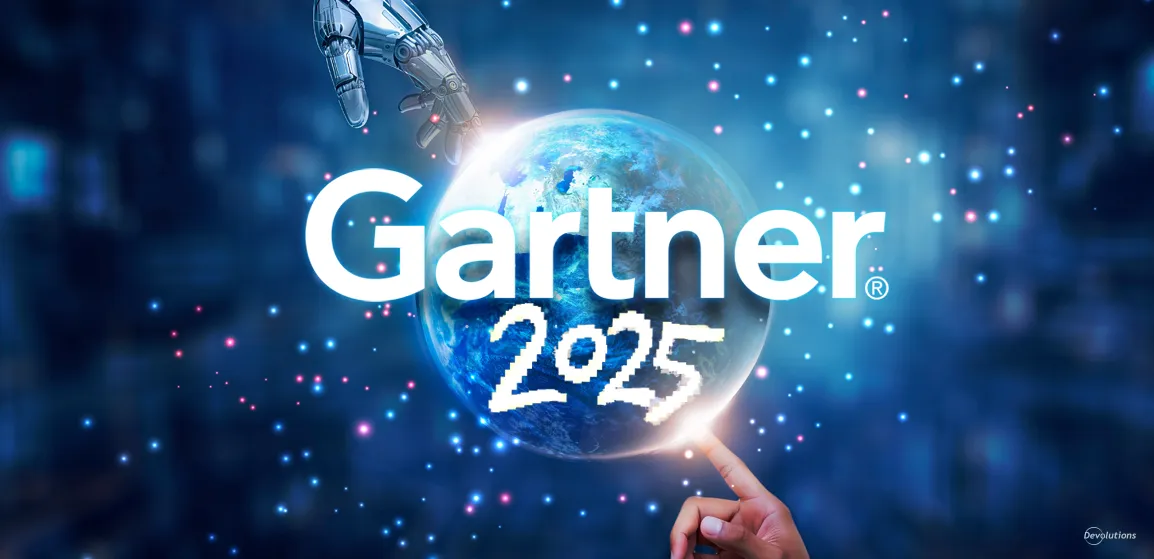Gartner has revealed its top 10 strategic technology trends for 2025. According to analysts, these core themes have the greatest potential to disrupt traditional business models, drive new forms of innovation, and address the most pressing challenges facing organizations today.
The 10 trends have been slotted into three categories:
- AI imperatives and risks: In order to combat disinformation, the rise of AI agents will require advancements in AI governance and new technologies.
- New frontiers of computing: Quantum computing will require new cryptographic methods, while low-cost sensors will unleash innovative business models.
- Human-machine synergy: Enhanced interactions between physical and virtual experiences will accelerate as robots integrate into daily life, driven by technologies that impact cognition and performance.
Below, we summarize each trend to understand its importance and impact. We also share some key statistics, and highlight use cases that bridge the gap from theory to reality:
Trend #1: Agentic AI
Category: AI imperatives and risks
About: Agentic AI refers to software that combines multiple AI techniques — such as memory, planning, and sensing the environment — to support autonomous and semi-autonomous decision making. The overall goal is to improve safety, efficiency, and productivity across the organization.
By 2028, an expected 33% of enterprise software applications will include agentic AI, up from less than 1% in 2024. This will allow 15% of day-to-day work decisions to be made autonomously.
Use cases:
- Enabling workers to develop and manage large, complicated technical projects through natural language.
- Automating and optimizing customer experiences by using data analysis to make accurate and calculated decisions at each step
- Generating faster data analysis and more accurate prediction intelligence to improve situational awareness, and drive better decision making.
Trend #2: AI governance platforms
Category: AI imperatives and risks
About: AI governance platforms manage and control AI systems by ensuring that they are used ethically, responsibly, transparently, fairly, and safely — ultimately establishing alignment across AI usage, the organization’s values, and broader societal goals and expectations.
Analysts forecast that by 2030, spending on off-the-shelf AI governance software will increase more than 4x, reaching $15.8 billion (all figures USD) and capturing 7% of overall AI software spending.
Use cases:
- Identifying, evaluating, and mitigating potential risks and hazards that AI systems may trigger, such as bias, privacy violations and negative societal impact
- Ushering AI models through a model governance process to ensure that all appropriate gates and controls are adhered to across the life cycle
- Tracking AI systems usage, performance, auditing, and decision-making processes, in order to ensure that they stay in alignment with evolving governance standards over time.
Trend #3: Disinformation security
Category: AI imperatives and risks
About: As we have discussed on the Devolutions blog, while the potential positive impact of AI is enormous and in some ways even profound, there is also a dark side to the story. Cybercriminals are relentlessly trying to breach AI systems, in order to manipulate models so they generate inaccurate outputs and make flawed decisions. The goal of disinformation security is to help detect and validate what can — and what cannot — be trusted, while at the same time monitor and publicize the spread of harmful content.
By 2028, an estimated 50% of organizations will adopt disinformation security-related strategies, systems, and tools, up from less than 5% in 2024.
Use cases:
- Detecting the use of synthetic media in authorized contexts, such as real-time communications and claims validation.
- Monitoring false narratives proliferated by cybercriminals and other bad actors that are spread through mass or social media, and which target corporate assets (e.g., brand and products) and people (e.g. executives and leaders).
- Detecting identity theft and attempts to impersonate individuals legitimately connected to an organization, such as employees, contractors, suppliers and customers.
Trend #4: Post-quantum cryptography (PQC)
Category: New frontiers of computing
About: For several decades, various cryptographic methods have been used to secure information systems and data. However, the emergence of quantum computing (which uses quantum mechanics to solve complex problems faster than classical computers) is expected to render many of these conventional methods obsolete. In fact, some cybercriminals are already adjusting to this shift by employing tactics such as “harvest now, decrypt later,” in which they exfiltrate data that they cannot decrypt at the present time, but expect to do so in the future by using quantum technology. That is (hopefully) where PQC enters the picture.
PQC refers to a generation of cryptographic methods that are designed to address and counter the potential threats posed by quantum computers. And time is definitely of the essence: security experts warn that quantum computing has the potential to break RSA and ECC encryption within hours, or possibly even minutes. And while AES is tougher to break, quantum computers have the capacity to crack this encryption standard in a fraction of the time compared to classical computers.
Use cases:
- Future-proofing systems to safeguard sensitive financial data in an increasingly quantum computer-dominated world.
- Protecting intellectual property from cyberthreats by blocking cybercriminals from decrypting confidential information, even if they use quantum computing.
- Ensuring that encrypted communications — such as messages, contracts and operational data — cannot be intercepted or decrypted.
Trend #5: Ambient invisible intelligence
Category: New frontiers of computing
About: Ambient invisible intelligence uses AI advances such as machine learning (ML), pervasive computing, and contactless sensors to track the location and status of various objects. The goal is to automatically harvest data from day-to-day environments, and autonomously make physical spaces inhabited by human beings (at work, home, and elsewhere) more responsive, comfortable, and safer.
The global ambient intelligence market is projected to reach $185.5 billion by 2032, up from $19.2 billion in 2022.
Use cases:
- Increasing the accuracy and functionality of smart home ecosystems, which (for example) learn over time that individuals prefer warmer temperatures during specific hours and adjust accordingly.
- Creating checkout-free retail environments that monitors the items customers gather while shopping, and automatically charges their credit/payment card when they leave the store.
- Continuously monitoring patients in hospitals or seniors in care homes, in order to provide rapid response and information sharing in emergencies.
Trend #6: Energy-efficient computing
Category: New frontiers of computing
About: As the name suggests, energy-efficient computing is about building and operating computers, data centers, and digital systems in ways that achieve necessary performance standards, yet at the same time reduce energy consumption and minimize carbon footprint. Technologies that have the potential to drive sustainable energy-efficient over the next 5-10 years include neuromorphic computing (designing hardware and software that simulates the neural and synaptic structures and functions of the brain to process information), and quantum computing (as discussed above in trend #4).
In 2025, data centers around the world that host cloud services are projected to consume 20% of global electricity, and emit up to 5.5% of the world's carbon emissions.
Use cases:
- Reducing data center costs by cutting the power consumption of servers and cooling systems.
- Using energy-efficiency computing to design products that consume less energy.
- Building smart power management systems to reduce power consumption across office networks.
Trend #7: Hybrid computing
Category: New frontiers of computing
About: Hybrid computing combines multiple technologies (such as CPUs, GPUs, edge devices, and ASICs) and systems (such as neuromorphic, quantum, biocomputing and photonic) to solve extremely complex computational problems. In order for hybrid computing to solve problems and achieve objectives within and beyond the enterprise, orchestration layers are necessary to coordinate data and interactions, and optimize efficiency in app development and deployment.
Year-over-year from 2024 to 2025, spending on cloud infrastructure and platform services (CIPS) is projected to grow 24.2%, spending on cloud application services (SaaS) is projected to grow 19.2%, spending on cloud desktop-as-a-service (DaaS) is projected to grow 11.1%, and spending on cloud system infrastructure services (IaaS) is expected to grow 24.8%.
Use cases:
- Keeping critical workloads in-house, and using the cloud to handle peak loads during busy periods.
- Storing sensitive data on-premises and meeting stringent data privacy regulations, and using the cloud for less sensitive operations or analytics.
- Leveraging cloud-based development tools, while maintaining secure on-premises environments for production.
Trend #8: Spatial computing
Category: Human-machine synergy
About: Spatial computing uses a mix of technologies including augmented reality (AR), mixed reality (MR) and AI in order to digitally represent people and objects, and anchors that digital content in the real world — ultimately creating an immersive, interactive environment. While many people are familiar with spatial computing applications in entertainment and gaming (through devices such as Apple Vision Pro and Meta Quest 3), it is also being used in areas such as retail, healthcare, ecommerce, training, and performance management.
By 2028, an estimated 20% of people around the world will experience persistently and geographically-anchored content at least once a week, up from less than 1% in 2023. The global spatial computing market is expected to reach 280.5 billion by 2028, up from 97.9 billion in 2023.
Use cases:
- Enabling workers who are not located in the same physical office or workspace to collaborate in immersive 3D environments.
- Running lifelike simulations to facilitate employee training, which can accelerate skill acquisition and improve overall safety.
- Providing customers with an interactive virtual assistant that accompanies them as they shop, and which offers relevant and up-to-date answers, advice, and information.
Trend #9: Polyfunctional robots
Category: Human-machine synergy
About: Unlike traditional task-specific robots, polyfunctional robots (also known as smart robots) are designed to handle multiple tasks. This opens up a whole new world of flexible, cost-effective applications across a variety of industries that are under increasing pressure to find new efficiencies and reduce costs, such as manufacturing and warehousing. In addition, polyfunctional robots are capable of learning new tasks through human instruction, rather than through expensive, complex, and time-consuming re-programming.
Analysts predict that by 2030, 80% of people will engage with polyfunctional robots on a daily basis, up from less than 10% today. And the size of the global polyfunctional robots market is projected to reach $21 billion in 2032, up from $8 billion in 2023.
Use cases:
- Handling various tasks in warehouse environments, such as picking, packing, and transporting goods.
- Handling various tasks in healthcare environments, such as delivering medical supplies, assisting patient mobility, and disinfecting spaces.
- Handling various tasks in field servicing environments (including those that are remote and hazardous), such as inspecting equipment, performing routine maintenance, and repairing breakdowns.
Trend #10: Neurological enhancement
Category: Human-machine synergy
About: Neurological enhancement (also known as cognitive enhancement) uses bidirectional brain-machine interfaces (BBMIs) to read and decode brain activity, in order to improve a person’s cognitive abilities and performance. The application of neurological enhancement operates on a spectrum: solutions with limited functionality (such as wearables) have low invasiveness and are relatively easier to adopt on a mass scale, while solutions with higher functionality (such as an implant) are highly invasive and are relatively more difficult to adopt on a mass scale.
By 2030, an expected 60% of IT workers will be “enhanced” by technologies such as bidirectional brain-machine interfaces (BBMIs). The global brain computer interface (BCI) market is projected to reach $6.2 billion in 2030, up from $1.74 billion in 2022.
Use cases:
- Providing students with personalized education material in real-time.
- Supporting the delivery of healthcare in multiple ways including prevention, detection, diagnosis, restoration, and rehabilitation.
- Creating an immersive gaming and entertainment experience that responds to and stimulates brain activity for greater engagement.
The final word
It has been said that the true measure of leadership is the ability to look beyond the present, in order to anticipate and prepare the future. According to Gartner (and many other analysts and industry leaders), these top 10 strategic technology trends for 2025 are a vital map and compass to help leaders make smart decisions and investments now, so their organization will be safe, strong, and successful on the journey ahead.
What’s your view?
What trend or multiple trends do you think will have the biggest impact in 2025 and beyond? Are you excited about the potential of some of these technologies and advancements? Are you apprehensive about how they could be manipulated and misused? Please share your views and predictions.





